After tearing his UCL in 2018, Michael Kopech underwent Tommy John Surgery which kept him out of the remaining 2018 season and the entirety of the 2019 baseball season as well. Kopech then opted out of the 2020 COVID pandemic season. After two and a half long years, the Prodigal Son returned in 2021 and Sox fans finally got a glimpse of what the highly touted righty could accomplish. And what Kopech could accomplish was glorious.
After the month of April, in 15.2 innings pitched, Kopech had an ERA of 1.72, a FIP of 1.32, and a whopping 27 strikeouts. Thanks to some double headers, Michael Kopech ended up starting a couple of games. On April 18th, Kopech went three innings against his former team, the Boston Red Sox, and struck out 4 batters in 3 innings. Kopech’s next appearance came against the Texas Rangers on April 25th when he struck out 10 batters in 5 innings. That’s all White Sox fans needed to see. Whatever fears you may have had about Kopech in the past were immediately dispelled. The Sox had a monster weapon on their hands.
At the end of May, Michael Kopech suffered a strained hamstring which placed him on the IL. The righty ended up missing the entire month of June as a result of the injury. His absence was a huge blow to the bullpen. At the time of his injury, Kopech had pitched 31.1 innings, while fanning 45 opposing batters with a 1.72 ERA and 2.60 FIP.
From what I saw on social media, this dominant version of Michael Kopech is the version that fans have cemented into their minds when they think of #34. The guy who can come in and strike out anyone he faces, no matter who is on base. Unfortunately, this wasn’t the case when Kopech returned to the team in July.
During 10 relief appearances and 11 innings in July, Michael Kopech gave up 6 earned runs, doubling the amount of runs he gave up in April and May. Kopech’s ERA rose from 1.72 to 2.55 by the start of August. Though, his K/9 stayed on track, and the righty managed to strike out 15 in a month.
Then the wheels really came off. For the remainder of the year, in an additional 27.0 innings, Kopech had a 5.00 ERA, though with a 3.28 FIP. He gave up 15 earned runs and 5 home runs. While the K’s still kept piling up, 43 during this stretch, so did the hits and earned runs.
The playoffs were not much better for Michael Kopech as the Houston Astros roughed him up. In two appearances totaling 3.0 innings, the Astros tagging the righty for 6 earned runs. Though again, the K/9 was there as Kopech still managed to strike out 5 batters.
So, what happened to Kopech?
Obviously, there was a divide in how Michael Kopech performed in the beginning of the season versus the end of the season. I’m not sure if the hamstring strain had anything to do with it, or if opposing teams just had more tape to work off of as the season went along, but his effectiveness was night and day. I took a look at Michael Kopech’s Baseball Savant page to see if I could find something, and I believe I did notice a trend.
I reviewed every time Michael Kopech threw a fastball to end an at-bat, whether doing so led to a strike out or otherwise. From this review, it appeared to me that Kopech was much more effective when he was able to throw high heat than when he was able to throw pitches in the bottom two-thirds of the plate.
The high heaters were effective for Michael Kopech all season long. For example, here’s #34 striking out Rangers slugger Joey Gallo for the second time on April 25th.
Kopech’s fastball floats high and away leaving Gallo to swing at just air. And below is an example of Michael Kopech striking out Boston’s Rafael Devers on another high fastball on September 11th, about four and half months later:
However, it’s the lower two thirds of the plate that seemed to be the difference pre and post hamstring strain, and I believe is a significant reason for the ERA differential pre injury and post injury. From what I can gather, Kopech didn’t throw a lot of lower fastballs, at least those fastballs that ended the at-bat. When he did, he was able to paint the edge of the zone in a way that he didn’t seem to be able to do post IL stint. For example, here is Kopech throwing a beauty of a pitch to Joey Gallo on a 3-2 which was the Rangers first strike out of the aforementioned game.
Or if an opposing batter was able to make contact when Kopech was painting, it still led to an out. Here’s Kansas City’s Salvador Perez making contact on a really good pitch from Kopech on May 8th, only to ground out to Tim Anderson:
However, opposing batters were able to find greater success against Michael Kopech when he didn’t throw it high in the second half of the season. Here’s Minnesota’s Josh Donaldson able to turn on a pretty good 96.6 mph heater at the middle edge of the zone on July 20th:
And on July 31st, Cleveland’s Austin Hedges ties the game on a 2-out single from a 96.7 mph four seam fastball Kopech leaves in the bottom of the zone:
Throughout the season, Michael Kopech has gotten burned going high (the very next play after the Hedges RBI above is Yu Chang hitting a triple off of a fastball hit middle high in the zone) and found success strikeout out batters low (for example, Kopech struck out Oakland’s Jed Lawrie on a 99.8 fastball low and away on August 16th). However, the trend I found browsing his Baseball Savant page is that Michael Kopech was hugely successful throwing fastballs in the top third of the plate (or just outside of it) and was less successful when he threw his four seamer in the bottom two thirds of the zone.
To further illustrate this point, let’s talk about the home runs hit off of a Michael Kopech fastball. Before I do that, I just want to share Baseball Savant’s break down of the strike zone which will be useful for this conversation.
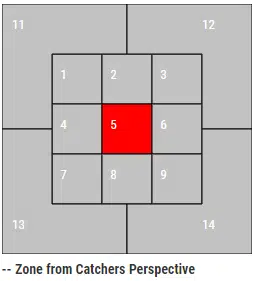
In 2021, including the post-season, six players have hit a total of seven home runs off of a Kopech fastball. Those players are Carlos Santana (twice), Salvador Perez, Josh Donaldson, Kyle Tucker, Gleyber Torres, and Brandon Marsh. Of those seven home runs, six were from fastballs thrown in the lower two-thirds of the plate (Zones 4-9). Three of the home runs were thrown in Zone 5, right in the middle of the plate: the Marsh homer, one of the Santana’s and the one hit by Gleyber Torres. The Josh Donaldson dinger, seen above, was thrown in Zone 4 and Kyle Tucker’s post season home run (we’ll get that shortly) was thrown in Zone 8. The only player to hit a home run high in the zone was Carlos Santana (thrown in Zone 1). Personally, I think that was just one where Santana and Kopech had seen a lot of each other throughout the year, Santana was able to win that chees match that day. To even things out, here’s a video of Michael Kopech striking out Carlos Santana with some high heat:
Out of all of the players to hit a home run off of Michael Kopech, the two least talented players were Gleyber Torres and Brandon Marsh. I believe they were able to find success due to Michael Kopech’s belief that he could throw meatballs, fastballs thrown right down the middle of the plate, to weaker players and get away with it. Frankly, for the most part, he’s right. For example, here’s Michael Kopech striking out Reds OF Aristides Aquino on August 29th.
On the flip side, below is Kopech throwing 100+ mph heat to LA’s Brandon Marsh. It’s a 3-2 count and the Angels outfielder ended up slashing .254/.317/.356 on the year while hitting only one other home run. I think this is probably the correct call to make and a good throw, just a tad bit of bad luck in that the Blind Squirrel eventually found his nut.
That being said, it’s not advisable to throw meatballs to good hitters. I know Carlos Santana isn’t going to win a home run derby any time soon, but he’s still talented enough to punish pitches thrown in the middle of the plate.
Even if the hits don’t leave the park, don’t throw meatballs to good players. And Toronto’s Bo Bichette is a good player.
Again, though, probably okay to throw meatballs to bad players. Even though he already hit a home run off of Kopech earlier in the game (off of a slider), here’s #34 blowing one right by Texas’s David Dahl on April 25th:
If for some reason you still have not been persuaded by my assessment of Michael Kopech, take a look at his Heatmaps pre and post hamstring strain. Here is what is looked like pre-injury:
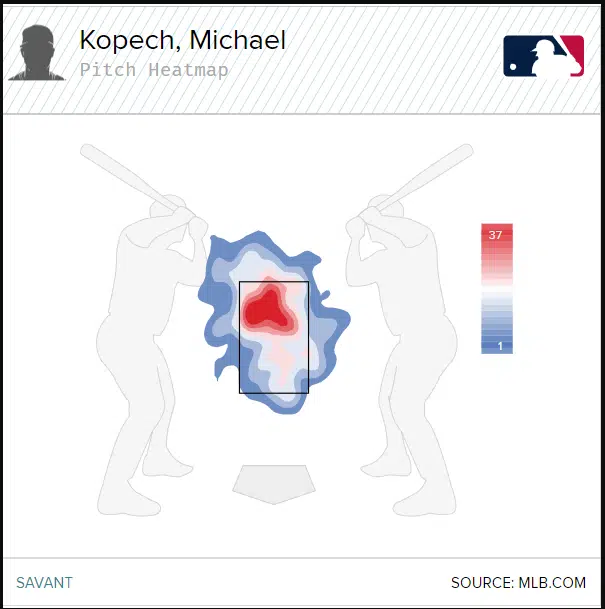
And here is what it looked like post-injury:
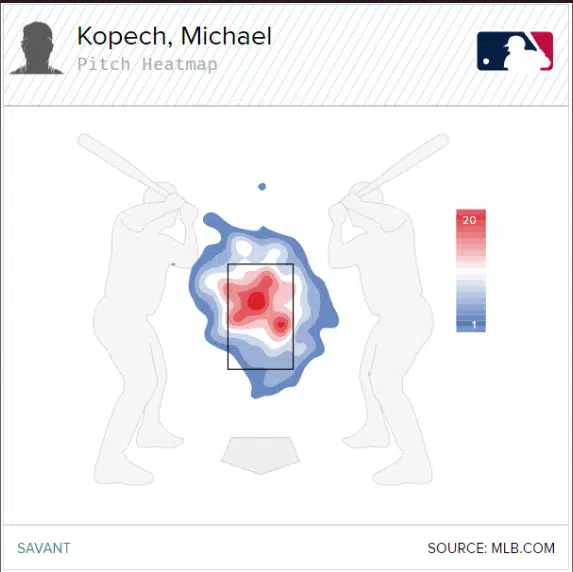
At the beginning of the season, when Michael Kopech was able to locate and concentrate his fastballs higher in the zone, he was one of the best and most dominant pitchers in the game. That was not the case after he came back from his extended IL stint. As you can see from the heatmap above, his fastballs are more sporadic and leaned towards the middle of the zone. Unsurprisingly, that led to Kopech being a significantly less effective pitcher for the remainder of the season.
Michael Kopech’s success, or sometimes lack thereof, with this fastball was exploited by the Houston Astros in the playoffs. He was able to strike outs batters when he threw his four seam fastball high and inside, but got burned when he tries to blow it past hitters either in the middle of the zone, or lower in the zone. Here is Kopech striking out Yordan Alvarez on a 3-2 count to end an inning by throwing him a 98.0 mph fastball high and outside (with some help thanks to Cane Guy):
Yet, watch what Kyle Tucker does with a 98.4 mph fastball middle low:
We’ve also seen Michael Kopech have varying degrees of success throwing meatballs to poor hitters. Generally, I think it’s a good idea, because no matter how much he’s struggling, it tends to work. That being said, even poor hitters are still professional hitters, and should be able to hit fastballs in the middle of the plate. Here is Kopech (re) learning that lesson the hard way a few days when he tries to get the Astros worst hitter (and a poor hitter in general) Martin Maldonado with a meatball on a 2-2 count:
To add insult to injury, Kopech gives another first pitch meatball to the Astros next batter, Jose Altuve:
Altuve is easily able to hit Kopech’s 95.3 mph four seam fastball that’s left over the middle of the plate, and Michael Kopech’s 2021 playoff campaign would be complete after this at-bat.
I reviewed a lot of at-bats and spent a lot of time on Michael Kopech’s Baseball Savant page, only to come to the extremely basic and obvious conclusion that Kopech’s successes and faults were just how baseball is played nowadays. Thanks to the Launch Angle Revolution, hitters now are getting better getting underneath pitches. Doing so is leading to more hits and home runs. Since it’s harder to get underneath high pitches, pitchers are now counteracting hitters game plans by going high and avoiding going low. Therefore, it’s not shocking that Kopech continued to have success going high and continually got burned when he started going low. Unless you can paint the lower corners of the plate, and Kopech certainly isn’t the only talented pitcher who has trouble doing so, it’s inadvisable for any pitcher to go low.
That leads to the question of Why? If Kopech was not having success when his pitches landed in the lower two-thirds of the plate, why were his fastballs landing there? It’s certainly possible the hamstring injury itself could have been a bigger issue than Kopech and the White Sox organization let on. However, I have neither the intelligence nor the time to review every single one of #34’s pitches thrown to review any flaws in his mechanics. However, there was something that stuck out looking at Kopech’s Statcast page. Here’s a look at his release points on his four-seam fastball pre-injury:
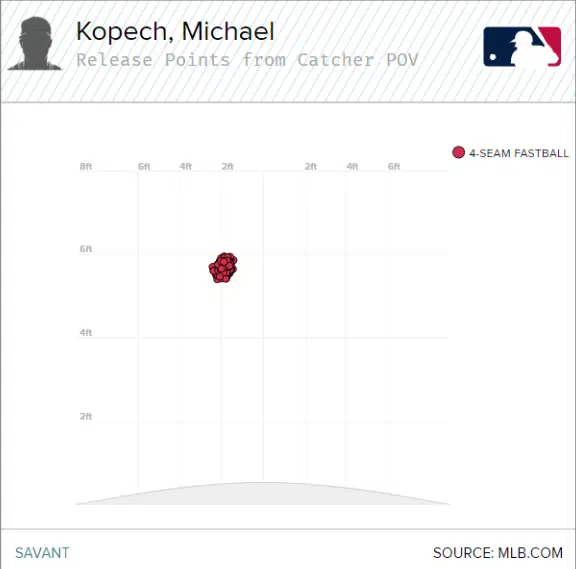
And here is a look at the release points post-injury:
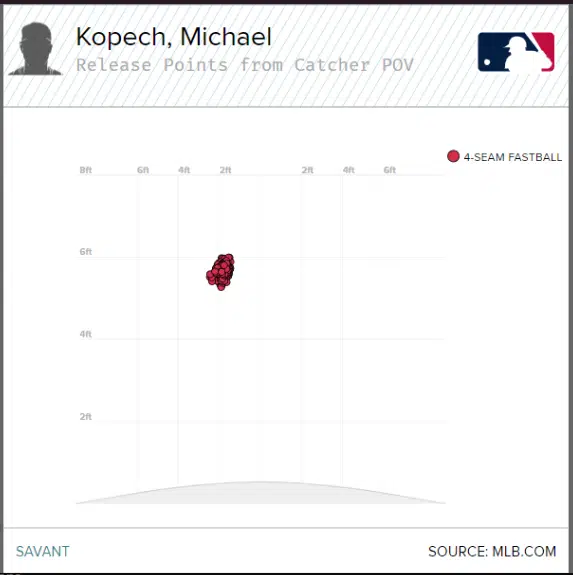
There is greater variance in Kopech’s release points on his fastball pre and post hamstring injury. When Michael Kopech was able to have a consistent release point on his four seamer, he was able to consistently throw it higher in the strike zone which led to the righty having a dominant start to the 2021 season. When Kopech started to have greater inconsistencies with his fastball release point, he started to have inconsistencies with locating his fastball which led to him getting lit up more in the second half of the season.
I am not going to claim that the injury itself was the cause on Kopech’s inability to consistently release his fastball where he wanted to. His injury came pretty early on in the season, that it could have just been fatigue on an arm that hadn’t thrown a professional pitch in many years prior. Or the success pre-injury could have been the result of small sample size. Regardless, it’s obvious there was some sort of fly in the ointment of Michael Kopech’s mechanics that led to a less successful end of his 2021 season.
That being said, personally, I am confident both in Michael Kopech’s talent as well as the talent of White Sox pitching coach Ethan Katz for the young pitcher to be able to right the ship for 2022 (assuming there is a baseball season in 2022). But I do believe something was wrong with Kopech when he came back to the team in July last season which led to a diminished lack of success, and I am hoping that won’t be the case for upcoming seasons now that Michael Kopech has joined the rotation as a starter.
Featured Photo: White Sox (@whitesox) / Twitter
